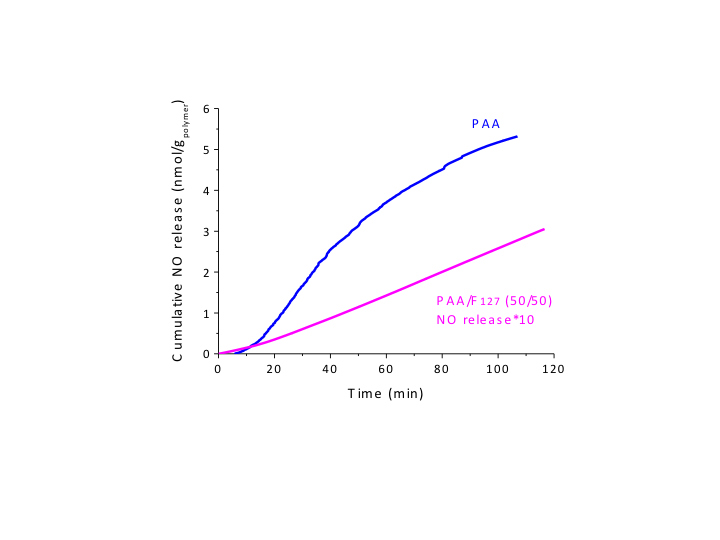Introduction: Nitric Oxide (NO) is an endogenous molecule that plays a key role in various biochemical processes, and the topical delivery of exogenous NO has shown to accelerate wound healing[1],[2]. The design of polymer-based NO delivery systems has been focused on systems capable of both preserving the NO charge during the storage and releasing NO slowly in a controlled manner. S-nitrosothiols such as S-nitrosoglutathione (GSNO) have been used as NO donors in biomaterials and can release NO both thermally and photochemically. In this work, we incorporated GSNO in a double network hydrogel of poly(acrylic acid) (PAA) crosslinked with N,N'-methylenebisacrylamide, interpenetrated with a network of the triblock copolymer PEO99-PPO65-PEO99 (Pluronic F127). Upon water absorption, the membranes were shown to release NO spontaneously at low rate and during prolonged time periods. applications.
Materials and Methods: Acrylic acid was polymerized by free radical polymerization in the presence of Pluronic F127 and N,N'-methylenebisacrylamide in distilled water at 30°C for 24 h. Double network membranes were prepared using PAA/F127 mass ratios of 30/70; 50/50; 60/40; 70/30 and 100/0 in glass molds, dialyzed for 7 days and lyophilized. The dry membranes were immersed in GSNO solution 40 mM for 4 h lyophilized again and stored in a desiccator. The GSNO loadings were determined by chemiluminescence using a Sievers NO analyzer.
Results and Discussion: The GSNO loadings were found to be ca. 6.0 wt% in pure dry PAA membranes and ranged from 0.6 to 1.3 wt% with the decrease in the PAA/F127 ratio from 70/30 to 30/70, respectively. While PAA led to highly porous hydrogel membranes (Fig. 1a) the interpenetration of PAA with F127 during the polymerization process led to dense membranes with the absence of pores in the micrometric scale (Fig. 1b). Dynamic-mechanical measurements showed that the hydrated interpenetrated PAA/F127 membranes are tougher and more flexible than the pure PAA membranes. These mechanical properties make the PAA/F127 membranes more suitable for topical applications. Representative NO release profiles from the PAA and PAA/F127 (50/50) membranes over 2 h are shown in Fig. 2. As expected, the PAA membrane with higher GSNO loading releases higher amounts of NO compared to the PAA/F127 membrane. However, the rate of NO release also decays faster in the PAA membrane, while the PAA/F127 membrane sustained an almost constant NO release during the time of monitoring. In both cases, the membranes were able to sustain a significant rate of NO release for 6 days, when kept in a constant hydration condition at 37°C in the dark. These data indicate that GSNO-containing PAA and PAA/F127 membranes have potential to be used for the topical delivery of NO in prolonged application times.

Figure 1. SEM images of the fracture surfaces of a) PAA and b) PAA/F127 (70/30) hydrogel membranes.

Figure. 2 Kinetic curves of real time NO release from GSNO-containing hydrogel membranes of crosslinked poly(acrylic acid) (PAA) and PAA interpenetrated with Pluronic F127 (PAA/F127), measured by chemiluminescence.
Conclusion: GSNO-containing PAA and PAA/F127 hydrogel membranes are capable of providing sustained NO release for prolonged time periods. Interpenetration of PAA with Pluronic F127 leads to a significant improvement in the mechanical properties of the membranes and may allow a slower rate of NO release in topical applications.
Fundacão de Amparo à Pesquisa do Estado de São Paulo - FAPESP (project 2015/24955-2)
References:
[1] Amadeu et al., J. Surg. Res., 2008, 149 (1), 84-93
[2] Shishido et al., Biomaterials 2003, 24 (20), 3543-3553